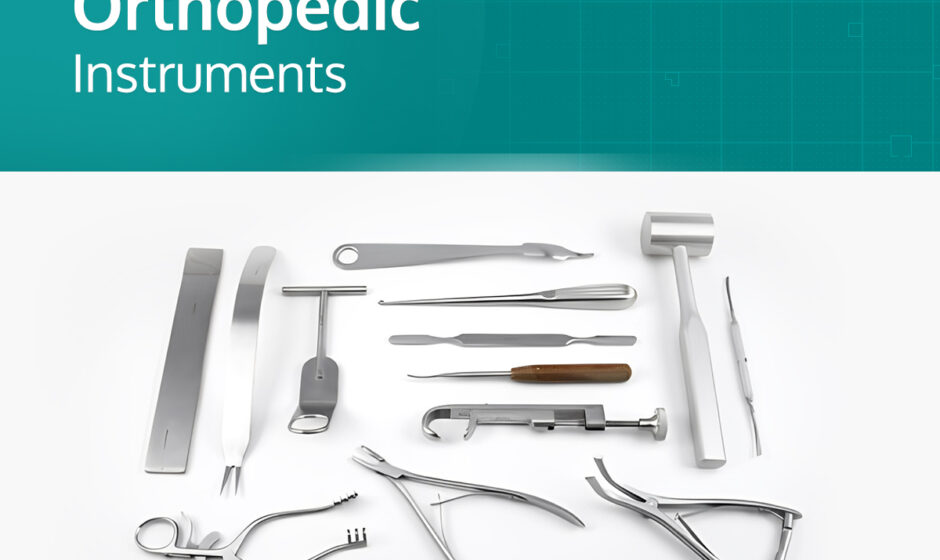Orthopedic surgery focuses on the treatment of bones, joints, and muscles. It helps people recover from injuries, accidents, and long-term conditions like arthritis. A successful orthopedic procedure depends on the skills of the surgeon and the quality of the tools they use. These tools, known as orthopedic instruments, are designed to perform specific tasks during surgery. Each type of instrument has a clear role and is selected based on the needs of the procedure. In this article, we will look at the various types of orthopedic surgical instruments and their uses.
Cutting Instruments in Orthopedic Surgery
Cutting is a basic part of most orthopedic surgeries. Whether the goal is to remove damaged bone or reshape a joint, accurate cutting is essential. To perform this task, surgeons use cutting orthopedic instruments such as bone saws, chisels, and osteotomes. These tools allow for clean, controlled cuts in hard bone tissue. Depending on the surgery, the instruments may be powered or hand-operated. A clean cut helps reduce trauma to the surrounding area and speeds up healing.
These cutting tools come in different sizes and shapes. Some are straight, while others are curved to reach specific areas. The right choice of tool depends on the bone’s location and the type of surgery being done. Orthopedic surgical instruments that cut with high precision help ensure that the results are smooth and well-shaped, which is especially important when fitting implants or plates.
Holding and Grasping Instruments
During surgery, it’s important to hold tissues and bones in place. This is where holding and grasping orthopedic instruments come into play. Instruments like forceps, clamps, and bone-holding pliers are used to keep the surgical site steady. These tools help the surgeon get a better view and make it easier to carry out the procedure without unwanted movement.
Grasping tools must have a strong grip without causing damage to the tissues or bone. They are also shaped to allow easy access to hard-to-reach areas. Some orthopedic surgical instruments in this category have locking features to maintain their position during longer procedures. Using the right holding instruments improves safety and allows the surgery to go smoothly.
Retractors for Better Visibility
One of the major challenges in orthopedic surgery is working in a limited space. To solve this problem, surgeons use retractors. These orthopedic instruments are used to pull back skin, muscles, and tissues so the bone or joint can be seen more clearly. Better visibility helps the surgeon work faster and with greater precision.
There are many types of retractors, each designed for a different part of the body. Some are self-retaining, meaning they stay open on their own, while others are manually held by the surgical team. Choosing the right retractor allows for better control of the operation and reduces the risk of injury to nearby tissues.
Instruments for Drilling and Reaming
In many orthopedic procedures, surgeons need to drill into bones to place screws, pins, or implants. Drilling and reaming instruments are used to make holes or widen existing ones. These tools are especially important in surgeries that involve the placement of plates or rods to fix broken bones.
Drilling orthopedic surgical instruments must be accurate to avoid damaging the bone or surrounding structures. Reamers, on the other hand, are used to shape the bone so that implants like joint replacements fit properly. Both tools are often used with guidance systems to make sure they are placed in the correct spot.
Measuring and Alignment Tools
Orthopedic surgery often involves working with small parts of the body where accuracy is key. Measuring and alignment orthopedic instruments help ensure that everything is placed correctly. Rulers, gauges, and alignment guides are used to check bone lengths, joint angles, and the size of the implants.
Using these tools during surgery ensures the right fit for all components. This helps the joint or bone function properly once healing is complete. Proper alignment also reduces the chance of long-term pain or the need for additional surgery.
Fixation Devices and Tools
Once a bone is cut or realigned, it needs to be fixed in place to heal. Fixation devices and tools are orthopedic instruments used to secure the bones. These include plates, screws, nails, and pins. Specialized instruments are used to insert and tighten these devices without harming the surrounding tissue.
The type of fixation instrument chosen depends on the type of fracture and the location of the bone. These tools are often used in trauma cases, where fast and secure fixation is needed. Fixation allows the bone to stay in the correct position while healing, which improves the chances of a full recovery.
Bone Shaping and Scraping Tools
Sometimes, orthopedic surgeons need to shape the bone or remove damaged tissue. Bone rasps, curettes, and scrapers are used for this purpose. These orthopedic instruments help smooth out rough surfaces, remove loose fragments, and prepare the area for implants or grafts.
These tools must be sharp and easy to control. Removing too much bone or damaging nearby areas can affect the outcome of the surgery. With the right tools, surgeons can carry out this step with care and accuracy.
Specialized Pediatric Orthopedic Instruments
Children often require different treatment than adults when it comes to bones and joints. Because their bones are still growing, pediatric orthopedic surgical instruments are made in smaller sizes and with special designs. These tools help surgeons treat birth defects, bone injuries, or conditions like scoliosis in young patients.
Using the right tools for children ensures safety and reduces the chance of long-term issues. These instruments allow doctors to treat young patients while supporting healthy growth and movement.
Technological Advancements in Instrument Design
Modern medicine has brought many changes to the design of orthopedic instruments. Today’s tools are lighter, more durable, and often include digital or robotic features. These new features help improve surgical accuracy and reduce the physical strain on surgeons.
Some orthopedic surgical instruments are now designed to work with robotic systems, giving real-time feedback and better control. These changes have made it easier to perform complex procedures with fewer risks and better outcomes.
Conclusion
Orthopedic instruments are a critical part of every bone and joint surgery. Each type of instrument is designed with a specific task in mind, from cutting and holding to drilling and fixing. The use of these tools allows surgeons to perform operations with greater accuracy, safety, and success. As technology continues to grow, orthopedic surgical instruments will keep improving, offering better care for patients of all ages. Understanding the types of tools used in orthopedic surgery helps highlight just how important they are in helping people regain movement, comfort, and a better quality of life.
More info: Artema Medical



